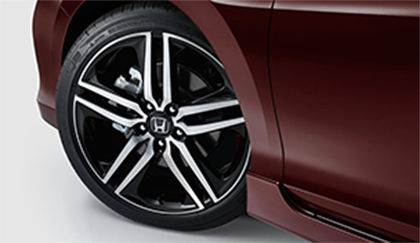Tire Centre
Tire StoreTire Information at Dalt's Honda
Tires are the most important part of your vehicle as they are the only point of contact between your vehicle Honda and the road. We understand the importance of having quality tires on a vehicle, but more importantly, the need to have tires that meet your needs. Our experts are here for you to help you find the tires that will best suit your lifestyle and driving style. We have a wide selection of summer and winter tires available at competitive prices. Plus, we regularly offer discounts and promotions on all our tires to help you save even more.
Tire Information
Tires are the most ignored and underrated component of your vehicle. They are the only interface between your Honda and the road to provide traction to accelerate, steer and stop. Your Honda dealer knows your vehicle best and will ensure it's equipped with the optimum choice of tire for your driving needs.
Winter Tires
Winter tires stay flexible in temperatures below 7°C to provide the necessary traction for cold-weather driving conditions.
They reduce braking distance on cold, wet, ice and snow-covered roads in comparison to all-season tires.
The traction provided by winter tires enhances the performance of anti-lock braking systems (ABS), vehicle stability assist (VSA), traction control and all-wheel drive in winter conditions.
Industry data shows that in cold weather, a vehicle equipped with winter tires has approximately a 40% less chance of being involved in a collision versus one equipped with all-season tires.
All-Season Tires
All-season tires are designed to provide traction and durability in a wide variety of seasonal road conditions. However, they cannot provide the same levels of traction in winter conditions as a proper winter tire.
They are best suited for use in temperatures above 7°C.
Extending the life of your tires
Tire Pressure
Studies have shown that up to 70% of vehicles on the road have at least one under-inflated tire. Checking and maintaining tire pressure regularly will help extend tire life and reduce fuel consumption. Every time you check your Honda°s tire pressures, you should also examine the tires for damage, foreign objects, and wear.
Wheel Alignment
Misaligned wheels can cause uneven and rapid tire wear. It is normal for wheel alignment to change through the life of the vehicle as wear accumulates and especially if the vehicle is driven on rough roads. If abnormal tire wear or damage is discovered when checking tire pressures or during vehicle maintenance, or your Honda has developed symptoms such as pulling to one side or that the steering wheel is not centred when driving straight, the wheel alignment should be checked and corrected if needed.
Wheel Balancing
Proper wheel balance helps prevent unnecessary wear to the tires, steering, and suspension components and also provides for a more enjoyable driving experience. Wheel balance normally changes as tires wear and should be checked periodically when you change or rotate tires, and especially if you have noticed speed-related vibration while driving.
Wheel balancing should always be done when replacing tires and when a tire has been removed from a wheel for any reason.
How to increase your fuel economy with tires?
Anything that increases a tire's rolling resistance or friction with the road surface will increase the amount of work required of the engine and therefore the amount of fuel it burns.
Tire Pressure
Under-inflation increases a tire's rolling resistance. Don't wait until your tires "look" low, or the TPMS (tire pressure monitoring system) warns you that your Honda's tire pressures are low before you check them.
Tires that are 56 kPa (8 PSI) low can increase fuel consumption by 4%. Think of the air to keep your tires at proper pressure as "free" gasoline.
Wheel Alignment
Wheel misalignment increases the resistance of the tires to roll in the direction of vehicle movement, which requires extra engine power to overcome and more fuel to be consumed. The increased "drag" caused could increase fuel consumption by up to 25%.
Tire Thread Depth
Automobile and light truck tires manufactured for sale in North America have wear indicators ("wear bars") moulded into the tire tread at 2/32" depth. This is the minimum legal tread depth permitted for use on public roads. When a tire's tread is worn level with the wear indicators in two or more adjacent tread grooves, the tire is considered illegal for further use and must be replaced.
Some all-season tires have a second wear indicator at 4/32" tread depth. When worn to this depth, an all-season tire may no longer be suitable for use in snow and may experience hydroplaning in severe wet conditions.
Winter tires may have a second wear indicator at 6/32" that indicates when the tire may no longer be suitable for use in snow.
Dalt's Honda is located in Orillia, Ontario and also serves Midland, Barrie, Gravenhurst, Bracebridge, Kawartha Lakes, Parry Sound, Huntsville, Collingwood, Lindsay and surrounding areas.

Service
| Days | Hours |
| Monday | 8:00AM / 5:00PM |
| Tuesday | 8:00AM / 5:00PM |
| Wednesday | 8:00AM / 5:00PM |
| Thursday | 8:00AM / 5:00PM |
| Friday | 8:00AM / 5:00PM |
| Saturday | Closed |
| Sunday | Closed |
call us
